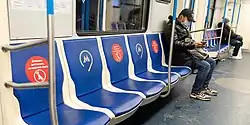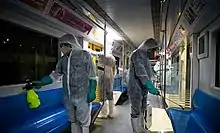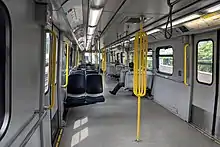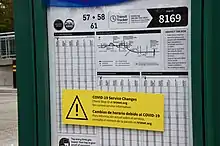Impact of the COVID-19 pandemic on public transport
The COVID-19 pandemic has had a significant impact on public transport.

There have been claims that the use of public transport has also led to the spread of COVID-19.[1] Results have not been conclusive on public transit's role as a substantial vector in the spread of COVID-19.[2] However its use still possesses a high risk of spread if social distancing, mask wearing and disinfection of "high touch" surfaces are not adhered to.[3]
Asia


China
On 23 January 2020, the entire Wuhan Metro network was shut down, along with all other public transport in the city, including national railway and air travel, to halt the spread of the virus.[4][5][6][7]
On January 24, 2020, the day after the lockdown was declared in the city of Wuhan, the Beijing Subway began testing body temperature of passengers at the entry points of 55 subway stations including the three main railway stations and the capital airport.[8] Temperature checks were expanded to all subway stations by January 27.[9] To further control the spread of the virus, certain Line 6 trains were outfitted with smart surveillance cameras that can detect passengers who are not wearing masks.[10]
On 28 March 2020, six lines of Wuhan Metro (Line 1, 2, 3, 4, 6, 7) resumed operation, after a two-month lockdown.[11] On 8 April 2020, Phase 1 of Line 8 resumed operation.[12] On 22 April 2020, Line 8 Phase 3, Line 11, Yangluo line resumed operations.[13]
China has largely contained the COVID-19 outbreak since June 2020, allowing for subway ridership and service to gradually recover to pre-pandemic levels.[14] Several Chinese metro networks broke historic daily ridership records on 2020's New Year's Eve.[15][16][17][18]
India
Various Indian states announced local and state level partial and incremental transport shutdown as early as March 11, 2020.[19]
Indonesia
Restrictions have been implemented to public transport in Jakarta, Indonesia.[20]
Transportation Ministry Greater Jakarta Transportation Agency (BPTJ) head Polana B. Pramesti said that Jakarta in particular had initiated various restrictions including transportation restrictions in March. "After the official, large-scale social restrictions (PSBB) status it can be ascertained that public transportation user numbers have declined as people’s mobility has been limited,” she added.[21]
Philippines
In the Philippines, public transportation has been suspended in Luzon as part of the implementing measures of the enhanced community quarantine.[22] In the absence of public transport, citizens could only resort to using their own private vehicle, but the critical role played by public transport cannot be replaced fully by private vehicles.[23] In June, several regions in Luzon that were previously in enhanced community quarantine were downgraded to general community quarantine, allowing the use of public transportation in limited capacity and subject to social distancing protocols.[24]
Turkey
On 20 March, free public transportation for people 65 years of age or older was temporarily suspended in Balıkesir, Konya and Malatya to encourage them to stay at home.[25] A day later, similar measures started to be imposed in Ankara, Antalya and İzmir.[26][27] On 24 March, it was announced that public transportation vehicles that work in and across the cities could fill up only 50% of their capacity with people at a time.[28]
Europe
Denmark
In August 2020, Denmark made face mask compulsory on public transport.[29]
France
Based on data released by Transit, France saw the largest decrease in use of public transport. This included a 92 percent decrease in Lyon and an 85 percent decrease in Nice.[30]
France will make face masks compulsory on public transport when it starts easing its coronavirus lockdown on 11 May, Prime Minister Edouard Philippe has said.[31]
Germany
In Germany, where lockdown measures have already been lifted, it's now mandatory to wear facemasks on public transport.[32]
Ireland
By April 2020, Dublin Airport was only running repatriation flights, or those with vital supplies (a reduction of more than 95% from the same week in 2019); Cork Airport was reduced to three return flights each day, all of which went to and from London, the first of which left at 4 pm and the last returning at 7:30 pm; Ireland West Airport had no commercial flights and both daily flights to and from Kerry Airport went to Dublin.[33]
On 27 March, the National Transport Authority announced that operators of public transport services are to move to a new schedule of services on a phased basis from 30 March. Revised timetables for Iarnród Éireann came into effect on 30 March, while those for Dublin Bus, Go-Ahead Ireland and Bus Éireann, came into effect on 1 April. Under the revised timetables, services ran at approximately 80% of current levels.[34] Many public transport timetables returned to normal by 29 June, but social distancing requirements meant that overall passenger capacity remained restricted.[35]
On 10 July, the Minister for Health Stephen Donnelly signed regulations to make the wearing of face coverings mandatory on public transport,[36] which came into effect on 13 July.[37] Those who refuse to comply to regulations can face fines of up to €2,500 and a possible jail sentence of six months.[38][39] Figures from the National Transport Authority showed levels of compliance of between 70% and 95% on buses, trains and trams.[40] Bus Éireann reported a compliance rate of 95% on its services, Iarnród Éireann said it was 90%, Dublin Bus reported a rate of about 80% and Luas said it was between 75% and 80%.[41] On 21 July, the Department of Health announced that face shields will be accepted as an alternative to a face covering on public transport.[42]
United Kingdom
Bus, plane and train services were reduced in the United Kingdom.[43] Public transport use has declined by around 90% in London since the national coronavirus lockdown was implemented. London's mayor Sadiq Khan has made all bus travel free from 20 April and told passengers to only board by the middle doors in a bid to protect bus drivers, after 20 of them died from Coronavirus.[32] Bus travel fares began to be reinstated from 23 May, after a conditional bailout of Transport for London by the Department for Transport.[44] From 15 June it became compulsory to wear a face covering on public transport in England.[45]
Throughout the pandemic, people had been told not to use public transport for non-essential travel, to help stop the spread of COVID-19 and allow for social distancing in carriages, for those who were unable to work from home. This advice was rescinded on 17 July, in advance of further easing of lockdown measures, including the removal of work from home advice.[46]
Based on data released by Moovit, the United Kingdom saw a significant decrease in use of public transport during April 2020. This included an 80% percent decrease in London and South East, 79% in Yorkshire, 71% in West Midlands, 80% in the South West, 76% in the North West and 78% in Scotland.[47]
North America
Canada

Based on data released by Transit, demand for public transport in Canada dropped an average of 83 percent in late March compared to previous years.[30] On March 17, the Edmonton Transit Service started using Saturday schedules for all of its routes 7 days a week.[48] On April 1, Calgary Transit also reduced service.[49] In Saskatoon, ridership had dropped by over 80 percent by March 30.[50]
Ridership on the Toronto Area's two largest transit agencies - specifically Toronto Transit Commission (TTC) and GO Transit - had fallen 80 to 90 percent by April 13,[51] and both had reduced service and/or suspended routes. The TTC and GO Transit have suspended the ability for customers paying their fares with cash (or tokens in the case for TTC services) on their public transit buses until further notice.[52][53] On April 14, Metro Vancouver's TransLink said they were losing C$75 million per month, and would need emergency funding or be forced to cut large amounts of local services.[54] In Montreal, the Metro reported an 80 percent drop in ridership by March 26. In the northern suburb of Laval, the STL had cut 45 percent of local bus service.[55]
United States


According to Government Technology, "Steep declines in ridership during the crisis have pushed public transit systems across the U.S. into deep financial distress."[56] Kim Hart of Axios wrote, "Public transit systems across the country are experiencing a painful trifecta: Ridership has collapsed, funding streams are squeezed, and mass transit won't bounce back from the pandemic nearly as fast as other modes of transportation."[57]
In Detroit, DDOT bus services were cancelled after drivers refused to work.[58]
The Verge reported a 18.65 percent ridership decline on the New York City Subway system for March 11 compared to one year prior. New York City Bus ridership decreased 15 percent, Long Island Rail Road ridership decreased 31 percent, and Metro-North Railroad ridership decreased 48 percent.[59] Sound Transit, operating in the Seattle metropolitan area, saw a 25 percent decrease in ridership in February compared to January, and the city's ferry ridership saw a 15 percent decline on March 9 compared to one week prior.[59] These declines became much more pronounced in late March and April, as widespread closures of schools and businesses and 'shelter-in-place' orders began to be implemented. USA Today reported in mid-April that demand for transit service was down by an average of 75 percent nationwide, with figures of 85% in San Francisco and 60% in Philadelphia.[60] Ridership on the Washington Metro was down 95 percent in late April.[61]
On April 7, SEPTA mandated that Philadelphia transit users wear face masks starting on April 9. On April 13, the agency said the rule would not be enforced.[62] On June 8, SEPTA again mandated that riders wear face masks.[63]
In order to prevent the spread of the virus on board buses and rail vehicles, some transit agencies have implemented temporary limits on the number of passengers allowed on a vehicle[64][65][60] and others have begun to require riders to wear face masks.[66][67] To reduce contact between drivers and passengers, several agencies have implemented rear-door-only boarding[61][68] and temporarily suspended the collection of fares,[60] examples including Seattle,[69] New York City buses,[70] and Denver.[68]
California
In California, Carson officials asked the Metro transit system to cease bus services in Los Angeles County.[71]
The San Diego Metropolitan Transit System (MTS) has reduced bus and Trolley (light rail) services following ridership decreases.[72] A vote on MTS' proposal to expand public transit in San Diego may not be possible in 2020.[73]
Bay Area Rapid Transit ridership plummeted by 90% prompting reduced service hours,[74] cut short turns on lines,[75] and longer train lengths to accommodate social distancing. Frequencies were reduced to half an hour per line.
Most services were shut down in San Francisco.[76]
New York
.jpg.webp)
Beginning March 25, service on buses and subways was reduced due to decreased ridership during the first wave of the COVID-19 pandemic in New York City.[77][78] In April 2020, four City Council members requested that subway service be temporarily suspended due to the spread of COVID-19 in the subway system.[79] In late March, NYCTA Interim President Sarah Feinberg stated that a shutdown "feels misguided to me" and was "not on the table".[80] Feinberg also spoke in favor of hazard pay for front-line workers.[80] The following month, Feinberg called the MTA "the most aggressive transit agency in the country in acting quickly and decisively to protect our workforce."[81] Starting in May 2020, stations were closed overnight for cleaning; the overnight closures would be a temporary measure that would be suspended once the pandemic was over.[82]
By April 22, 2020, COVID-19 had killed 83 agency employees; the agency announced that their families would be eligible for $500,000 in death benefits.[83][80] By May 1, 98 transit workers had died.[84]
Oregon
Oregon's largest transit agency, TriMet, started to require facial coverings for both passengers and operators. Oregon has gone so far as to allow people to order facial coverings. Oregon's governor Kate Brown issued an executive order 20–12, ruling on public transit and requirements for safe travel in Oregon.[85][86] With these requirements, TriMet is required to clean vehicles every four hours, and recommended to sanitize high-touch surfaces, provide facial coverings and sanitizer, if possible. There are many exceptions to the rule that include people with disabilities and other health issues, and those concerned about profiling because of wearing a mask.[85] Other public transit operators in Oregon, such as Amtrak, have reduced services as well.
Oceania
New South Wales
In order to observe physical distancing and to limit the spread of COVID-19, green dots have been placed throughout the public transport network to guide commuters on where to stand and sit. Transport for NSW has recommended commuters wear face mask when using public transport.[87]
On 7 July, NSW TrainLink temporarily suspended services in and out of Victoria due to border restrictions implemented by New South Wales.[88]
Based on data released by [Moovit], public transport ridership in NSW decreased by 75% April 2020.[89]
Victoria
The Victorian government has made it mandatory to wear face masks when using public transport.[90]
Spread of the coronavirus
[1] A study published in the academic journal Practical Preventive Medicine found that "in a closed environment with air-conditioning, the transmission distance of the new coronavirus will exceed the commonly recognised safe distance."[1]
At the same time, studies have failed to show evidence that public transit poses a risk of coronavirus outbreaks.[2] Furthermore, there is growing evidence that public transit riders do not face a higher infection risk.[91]
In Israel, one rider who was a carrier of the coronavirus was apprehended "on a bus on its way to Jerusalem, on suspicion of deliberately spreading the disease."[92]
Hazard controls
The U.S. Centers for Disease Control and Prevention has issued guidance documents on COVID-19 prevention measures for public transportation.[93][94][95] Drivers and passengers should wear face coverings, avoid frequently touched surfaces, and sit at least six feet apart if possible. To protect bus transit operators, passengers can enter and exit through the rear door. Frequently touched surfaces should be routinely cleaned. Signage and other visual cues such as decals and tape can alert passengers on appropriate COVID-19 precautions and seat designations. Travelers are encouraged to carry hand sanitizer and disinfectant wipes with them. It is best to travel during non-peak hours when it is easier to be physically distanced from other passengers.
References
- Chen, Stephen (9 March 2020). "Coronavirus can travel twice as far as official 'safe distance', study says". South China Morning Post. Retrieved 20 April 2020.
- Joselow, Maxine (2020-07-28). "There Is Little Evidence That Mass Transit Poses a Risk of Coronavirus Outbreaks". Scientific American. Retrieved 2020-10-10.
- à 13h58, Par Nicolas Berrod Le 5 juin 2020 (2020-06-05). "Coronavirus : pourquoi aucun cluster n'a été détecté dans les transports". leparisien.fr (in French). Retrieved 2021-01-06.
- "Public Transport In Wuhan Suspended Due To Coronavirus Concerns". NPR. Retrieved 2020-01-23.
- "Virus-hit Chinese city shuts public transport". BBC News. 23 January 2020. Retrieved 2020-01-23.
- "Coronavirus: Wuhan shuts public transport over outbreak". BBC News. January 23, 2020. Retrieved April 14, 2020.
- Lovelace Jr., Berkeley (January 22, 2020). "Public transportation suspended in China city to combat coronavirus outbreak". CNBC. Archived from the original on March 13, 2020. Retrieved April 14, 2020.
- "北京道路省际客运今起全部停运" 北京青年报 26 January 2020.
- (Chinese) "北京地铁将全路网推行测温 体温超37.3℃就需隔离" 人民网 27 January 2020.
- Beijing's 'intelligent' metro line able to identify unmasked passengers. Xinhua News Agency via China News Service, 9 April 2020.
- "Wuhan buses hit the road after two-month lockdown". Xinhua News Agency. 25 March 2020. Retrieved 2020-03-25.
- Huang Lei;Wang Yang (7 April 2020). "武汉:4月8日起恢复出租车运营 适时恢复网约车运营". Hubei Daily.
- "8号线三期、11号线、阳逻线恢复运营,22日起,武汉地铁全线网恢复正常". 2020-04-21.
- "How China Kept Transit Running During Covid-19". Institute for Transportation and Development Policy. 2020-07-03. Retrieved 2021-01-04.
- "刷新!成都地铁单日客运量再创新高".
- "404.81万人次!西安地铁客运量昨日再创新高".
- "2020年最后一天南宁地铁客流创新高-新华网". www.gx.xinhuanet.com. Retrieved 2021-01-04.
- "2020年最后一天 南昌地铁客运量首次突破百万-江西-手机江西网". m.jxnews.com.cn. Retrieved 2021-01-04.
- Gettleman, Jeffrey; Schultz, Kai (March 24, 2020). "Modi Orders 3-Week Total Lockdown for All 1.3 Billion Indians". The New York Times. Retrieved April 15, 2020.
- "Indonesia Orders Coronavirus Transport Curbs as Death Toll Rises". The New York Times. Reuters. April 12, 2020. Retrieved April 14, 2020.
- Post, The Jakarta. "The Jakarta Post - Always Bold. Always Independent". The Jakarta Post. Retrieved 2020-05-27.
- Regan, Helen (March 17, 2020). "Malaysia and the Philippines enact sweeping measures, as coronavirus cases jump in Southeast Asia". CNN. Archived from the original on April 13, 2020. Retrieved April 14, 2020.
- "EcoMobility". EcoMobility. Retrieved 2020-05-27.
- "Mass Transportation - Dashboard Philippines". covid19.gov.ph. Retrieved 2020-11-14.
- "Belediyeler, 65 yaş üstüne ücretsiz ulaşımı durduruyor". memurlar.net. 20 March 2020. Archived from the original on 22 March 2020. Retrieved 22 March 2020.
- "Ankara ve İzmir belediyeleri duyurdu: 65 yaş ve üstünün ücretsiz ulaşım kartları iptal edildi". Cumhuriyet. 21 March 2020. Archived from the original on 22 March 2020. Retrieved 22 March 2020.
- "Antalya'da 65 yaş üstü ücretsiz ulaşım kartları durduruldu!". Sözcü. 21 March 2020. Archived from the original on 22 March 2020. Retrieved 22 March 2020.
- "Marketlere ve toplu taşıma araçlarına yönelik koronavirüs tedbirleri artırıldı". Anadolu Agency. 24 March 2020. Retrieved 24 March 2020.
- https://www.thelocal.dk/20200821/denmarks-face-mask-requirement-comes-into-force-these-are-the-rules-you-need-to-know
- "How COVID-19 is affecting public transit use". CBC News. March 27, 2020. Archived from the original on April 7, 2020. Retrieved April 14, 2020.
- "BBC - Homepage". www.bbc.com. Retrieved 2020-05-27.
- "The World Economic Forum". World Economic Forum. Retrieved 2020-05-27.
- O'Shea, Cormac (1 April 2020). "Inside near-empty Dublin Airport and Cork Airport with just three planes a day flying in one". Irish Mirror. Retrieved 20 July 2020.
- "New Public Transport Timetables to take effect starting Monday". Transport for Ireland. 27 March 2020. Retrieved 21 July 2020.
- "Ireland's response to COVID-19: Transport and travel measures". gov.ie. Department of Transport, Tourism and Sport. 27 March 2020. Retrieved 21 July 2020.
- "Minister for Health signs regulations for the mandatory wearing of face coverings on public transport". gov.ie. Department of Health. 10 July 2020. Retrieved 21 July 2020.
- "COVID-19 Information - Transport for Ireland". Transport for Ireland. 15 July 2020. Retrieved 21 July 2020.
- Horgan-Jones, Jack; Wall, Martin (10 July 2020). "Non-wearers of masks on public transport face fine and jail sentence". The Irish Times. Retrieved 21 July 2020.
- "Fines, jail for non-compliance with face coverings law". RTÉ News and Current Affairs. 10 July 2020. Retrieved 21 July 2020.
- Ryan, Órla (2 July 2020). "Half of Dublin Bus passengers are wearing face masks but compliance on transport varies widely". TheJournal.ie. Retrieved 21 July 2020.
- McGreevy, Ronan (13 July 2020). "High compliance with rule making face coverings mandatory on public transport". The Irish Times. Retrieved 21 July 2020.
- McNally, Tadgh (21 July 2020). "Face shields are now an acceptable face covering on all public transport". TheJournal.ie. Retrieved 21 July 2020.
- "Coronavirus: What's the risk of taking buses or trains?". BBC News. March 26, 2020. Archived from the original on April 5, 2020. Retrieved April 14, 2020.
- "Contactless and Oyster cards reinstated on more than 1,000 buses". tfl.gov.uk. Transport for London. Retrieved 23 July 2020.
- https://www.gov.uk/government/news/face-coverings-to-become-mandatory-on-public-transport
- "Prime Minister's statement on coronavirus (COVID-19): 17 July 2020". Gov.uk. Prime Minister's Office, 10 Downing Street. Retrieved 23 July 2020.
- "Impact of Coronavirus (COVID-19) on Public Transit usage". Moovit Insights. Retrieved 3 December 2020.
- Mertz, Emily (March 16, 2020). "Coronavirus: Edmonton reduces public transit service as part of COVID-19 response". Global News. Corus Entertainment. Archived from the original on April 5, 2020. Retrieved April 14, 2020.
- Dormer, Dave (April 1, 2020). "Calgary Transit reducing frequency of buses and trains in response to COVID-19". CTV News. Bell Media. Archived from the original on April 4, 2020. Retrieved April 14, 2020.
- MacPherson, Alex (March 30, 2020). "Transit ridership plummets more than 80 per cent amid pandemic". Saskatoon StarPhoenix. Postmedia. Retrieved April 17, 2020.
- Jeffords, Shawn (April 13, 2020). "Transit ridership, revenue in steep decline during COVID-19 pandemic | National Post". National Post. Postmedia. Retrieved April 14, 2020.
- "Coronavirus update". Toronto Transit Commission. Archived from the original on April 10, 2020. Retrieved April 14, 2020.
- "Train Schedule Changes". GO Transit. April 2020. Archived from the original on April 14, 2020. Retrieved April 14, 2020.
- "TransLink says it's losing $75M a month and faces 'really unpleasant options' without emergency funding". CBC News. Canadian Broadcasting Corporation. April 14, 2020. Retrieved April 14, 2020.
- Rowe, Daniel J.; Thomas, Katelyn (March 26, 2020). "Public transit agencies in the Montreal area cut services due to impact of COVID-19". CTV News. Bell Media. Retrieved April 15, 2020.
- Vijaya, Ramya (April 14, 2020). "Coronavirus Lockdowns Are Pushing Mass Transit Systems to the Brink – and Low-Income Riders Will Pay the Price". Government Technology. Archived from the original on April 14, 2020. Retrieved April 14, 2020.
- Hart, Kim (April 8, 2020). "Public transit's death spiral". Axios. Archived from the original on April 11, 2020. Retrieved April 14, 2020.
- Chappell, Bill; Romo, Vanessa (March 17, 2020). "Coronavirus: All 50 States Report Cases; South America Has Nearly 1,000 Cases". NPR. Retrieved April 15, 2020.
- Hawkins, Andrew J. (March 13, 2020). "Coronavirus is taking a big bite out of public transportation ridership in the US". The Verge. Archived from the original on March 29, 2020. Retrieved April 14, 2020.
- Hughes, Trevor (April 14, 2020). "Poor, essential and on the bus: Coronavirus is putting public transportation riders at risk". USA Today. Archived from the original on May 3, 2020. Retrieved May 4, 2020.
- George, Justin (April 11, 2020). "For many 'essential workers,' public transit is a fearful ride they must take". The Washington Post. Retrieved May 4, 2020.
- Hider, Alex (April 13, 2020). "Philadelphia public transit won't require masks after viral video shows cops carry man off bus". WEWS-TV. Retrieved April 15, 2020.
- "SEPTA now requiring riders to wear masks". Philadelphia, PA: WPVI-TV. June 8, 2020. Retrieved June 21, 2020.
- Groover, Heidi (April 2, 2020). "Metro places passenger limits on buses to strengthen social distancing amid coronavirus outbreak". The Seattle Times. Archived from the original on April 29, 2020. Retrieved May 4, 2020.
- Theen, Andrew (April 22, 2020). "TriMet placing 'don't sit here' signs on bus seats, limiting passengers to 15 per bus". The Oregonian. Archived from the original on April 2, 2020. Retrieved May 4, 2020.
- Guse, Clayton (April 12, 2020). "NJ Transit riders required to wear masks during coronavirus pandemic, MTA still 'recommending' them". New York Daily News. Retrieved May 4, 2020.
- "LTD: 'Passengers need face masks covering nose and mouth to ride buses'". Eugene, Oregon: KVAL. April 7, 2020. Retrieved May 4, 2020.
- Minor, Nathaniel (April 3, 2020). "RTD To Stop Collecting Fares, Allow Rear-Door Boarding To Fight Coronavirus". Colorado Public Radio. Archived from the original on April 7, 2020. Retrieved May 4, 2020.
- Switzer, Jeff (March 21, 2020). "King County Metro to discontinue fare collections, direct riders to board buses at rear doors, beginning March 21". Seattle: King County Metro. Retrieved May 4, 2020.
- Layne, Nathan (May 1, 2020). "Overnight closure of New York subways may presage bigger changes". Reuters. Retrieved May 4, 2020.
- Garcia, Sid (April 3, 2020). "Carson officials ask Metro to suspend transit service throughout LA County". KABC-TV. Retrieved April 15, 2020.
- Smith, Joshua Emerson (April 7, 2020). "MTS to cut service as bus driver tests positive for coronavirus". The San Diego Union-Tribune. Retrieved April 15, 2020.
- Smith, Joshua Emerson (April 10, 2020). "Coronavirus threatens to derail San Diego's plans to expand public transit". The San Diego Union-Tribune. Archived from the original on April 13, 2020. Retrieved April 14, 2020.
- Asperin, Alexa Mae (23 March 2020). "BART starts reduced service schedule after decline in ridership". Newstar Media. KRON. Retrieved 25 March 2020.
- Savidge, Nico (18 March 2020). "Coronavirus fallout: BART shutting down at 9 p.m., VTA giving fare-free rides". East Bay Times. Retrieved 25 March 2020.
- Canales, Katie (April 7, 2020). "Almost all of San Francisco's public transit will be shut down as the city continues to fight the coronavirus disease". Business Insider. Archived from the original on April 8, 2020. Retrieved April 14, 2020.
- "Coronavirus New York: MTA launches essential schedule amid COVID-19 crisis". ABC7 New York (WABC-TV). March 24, 2020. Archived from the original on March 26, 2020. Retrieved March 26, 2020.
- "MTA Slashes Service, NJ Transit on Reduced Schedules". NBC New York. March 24, 2020. Archived from the original on March 26, 2020. Retrieved March 26, 2020.
- "Gov. Cuomo urged to shut down NYC subways to stop coronavirus spread". New York Post. April 18, 2020.
- "Sarah Feinberg is focused on the subway's survival | CSNY". Cityandstateny.com. March 25, 2020. Retrieved April 23, 2020.
- Meyer, David (April 20, 2020). "MTA chair passes blame to health officials as agency's coronavirus death toll tops 80". New York Post. Retrieved May 5, 2020.
- Goldbaum, Christina (2020-04-30). "N.Y.C.'s Subway, a 24/7 Mainstay, Will Close for Overnight Disinfection". The New York Times. ISSN 0362-4331. Retrieved 2020-04-30.
- Guse, Clayton (April 14, 2020). "MTA promises $500k in death benefits for coronavirus victims". New York Daily News. Retrieved April 16, 2020.
- Guse, Clayton; Rayman, Graham (May 1, 2020). "MTA chairman says 98 transit workers dead from coronavirus". New York Daily News. Retrieved May 5, 2020.
- https://www.oregon.gov/odot/RPTD/Pages/Coronavirus.aspx
- https://govstatus.egov.com/or-covid-19
- "Physical distancing on transport key to a safe pathway back to work". State of New South Wales. Retrieved 4 October 2020.
- "NSW TrainLink will temporarily stop services to Victoria". Transport for New South Wales. Retrieved 4 October 2020.
- "Impact of Coronavirus (COVID-19) on Public Transit usage". Moovit Insights. Retrieved 2 December 2020.
- "Wearing a face mask on public transport". Public Transport Victoria. Retrieved 4 October 2020.
- O'Sullivan, Feargus (2020-06-09). "In Japan and France, Riding Transit Looks Surprisingly Safe". Bloomberg CityLab. Retrieved 2020-10-10.
- "Virus carrier nabbed on bus to J'lem, accused of deliberately endangering public". The Times of Israel. 5 April 2020. Retrieved 20 April 2020.
- CDC (2020-02-11). "Protect Yourself When Using Transportation". Centers for Disease Control and Prevention. Retrieved 2020-08-10.
- CDC (2020-04-30). "What Rideshare, Taxi, Limo, and other Passenger Drivers-for-Hire Need to Know about COVID-19". Centers for Disease Control and Prevention. Retrieved 2020-08-10.
- CDC (2020-04-30). "COVID-19 Employer Information for Bus Transit Operators". Centers for Disease Control and Prevention. Retrieved 2020-08-10.
External links
 Media related to Public transport during the COVID-19 pandemic at Wikimedia Commons
Media related to Public transport during the COVID-19 pandemic at Wikimedia Commons
